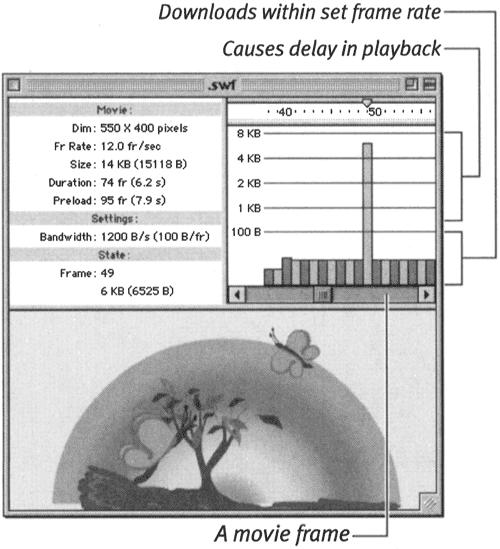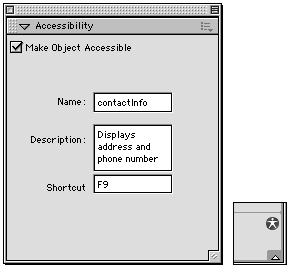| When you create movies to show over the Web, you must face the issue of quality versus quantity. Higher quality (smoother animation and better sounds) increases file size. The larger the file, the longer the download time and the slower your movie will be. Things that add to your file's size include lots of bitmaps ( especially animated bitmaps), video clips, sounds, lots of keyframes instead of tweening, multiple areas of animation at one time, embedded fonts, gradients, and separate graphic elements instead of symbols and groups. To help you find out where your movie is bogging down, Flash offers simulated streaming. The Size Report and Bandwidth Profiler reveal which frames will cause hang-ups. You can then rethink or optimize the problem areas. To use Bandwidth Profiler: -
Open the Flash document that you want to test for playback over the Web. -
From the Control menu, choose Test Movie (or Test Scene). Flash exports the movie and opens it in Flash Player. -
From Flash Player's Debug menu, choose the download speed that you want to test. The menu lists six speeds, all of which are customizable. To change them, choose Debug > Customize (Figure 16.1). By default, Flash lists three common modem speeds14.4 Kbps, 28.8 Kbps, and 56 Kbpsset to simulate real-world data-transfer rates (Figure 16.2). Figure 16.1. To create a custom connection speed for simulating playback over the Web, from the test environment's Debug menu, choose Customize.  Figure 16.2. At its default setting, Flash offers choices for simulating three standard modem speeds. To imitate the real world more accurately, Flash simulates a data-transfer rate of 1.2 KBps for a 14.4 Kbps modem (not the theoretically possible rate of 1.7KBps). Flash simulates 28.8 Kbps and 56 Kbps modems at 2.3 KBps and 4.7 KBps, respectively. You can change the test names and rates in the Custom Modem Settings dialog box.  -
From Flash Player's View menu, choose Bandwidth Profiler (Figure 16.3). Figure 16.3. To view a graph of the amount of data in each frame, choose View > Bandwidth Profiler when a Flash Player window is open.  At the top of the Test Movie window, Flash graphs the amount of data that is being transmitted against the movie's Timeline (Figure 16.4). The bars represent the number of bytes of data per frame. The bottom line (highlighted in red) represents the amount of data that will safely download fast enough to keep up with the movie's frame rate. Any frame that contains a greater amount of data forces the movie to pause while the data downloads. Figure 16.4. The Bandwidth Profiler graph at the top of the Flash Player window shows you how much data each movie frame contains and where the movie will pause to download data. Each bar represents a frame of the movie.  Flash offers you two ways to view the bandwidth graph. To view the contents of each frame separately: -
From the View menu, choose Frame by Frame Graph, or press  -F (Mac) or Ctrl-F (Windows). -F (Mac) or Ctrl-F (Windows). Flash presents a single bar for each frame in the Bandwidth Profiler graph. The numbers along the top of the graph represent frames (Figure 16.5). The height of the bar represents the amount of data in that frame. Figure 16.5. In Frame by Frame Graph mode, the height of each bar indicates how much data the frame holds. If the frame extends above the bottom line of the graph, the movie must pause to download the frame. In this movie, Frame 49 will cause a pause in playback.  -
Select a bar. Specifics about that frame and the movie in general appear in the profile window. To see how frames stream: -
From the View menu, choose Streaming Graph, or press  -G (Mac) or Ctrl-G (Windows). -G (Mac) or Ctrl-G (Windows). Flash displays the frames as alternating bars of light and dark gray, sized to reflect the time each one takes to download (Figure 16.6). The numbers along the top of the streaming graph represent frames as a unit of time based on the frame rate. (In a 12-fps movie, for example, each number represents 1/12 second.) For frames that contain very little data, you might see several bars in a single time unit in the graph. Frames that have lots of data stretch out over several time units. Figure 16.6. In Streaming Graph mode, the width of each bar indicates how long the frame takes to download at the given connection speed and frame rate. In this movie, Frame 49 contains 6KB of data and takes roughly 5 seconds to download at a frame rate of 12 fps over a 14.4 Kbps modem. Each number along the top of the graph is a frame, and at 12 fps, this equals 1/12 second.  -
Select a bar. Specifics about that frame and the movie in general appear in the left profile window. With either type of graph, you can make Flash simulate the time it takes your movie to load at various connection speeds. To display a download-progress bar: -
From Flash Player's Control menu, choose Show Streaming, or press  -Return (Mac) or Ctrl-Enter (Windows). -Return (Mac) or Ctrl-Enter (Windows). As the animation plays in the test window, Flash highlights the numbers of the Timeline in green to show where you are in the download progress. To exit Bandwidth Profiler:  Tips Tips -
After you set up a test environment incorporating the Bandwidth Profiler, you can open any .swf file directly in test mode. Choose File > Open, navigate to the file that you want to test, and then click Open. Flash opens the movie in a Flash Player window, using the bandwidth profile and other viewing options that you selected. -
You can get a printed version of the information about the amount of data in each frame. Choose the Generate Size Report option in the Export Flash Player dialog box or the Flash tab of the Publish Settings dialog box (for more information, see "Publishing and Exporting" later in this chapter). During the export or publishing process, Flash simultaneously creates a text file documenting how many bytes of information each frame of the movie contains.
A Note About Accessibility As you think about the best ways to deliver Flash movies to your audience, you should also consider the fact that some members of that audience may have physical conditions that affect the way they interact with your site. As the Web has become more of a visual medium, it presents challenges to users with visual impairments who want to take advantage of the many resources available there. Our society is becoming more sensitive to the ways in which activities and resources exclude people with disabilities . Web designers need to think about using Flash not only to make eye-catching Web sites that dazzle with artwork, animation, interactivity, sound, and video, but also to make sites that can convey information to a wide range of people, some of whom are unable to view the site's content. Flash MX addresses the issue of accessible Web sites by allowing you to make Flash content available to screen-reading software that uses Microsoft Active Accessibility (MSAA) technology. (At the time Flash MX was released, MSA was available only for Windows.) Screen readers provide audio feedback about a variety of elements on a Web site, reading aloud the labels of buttons , for example, or reading the contents of text fields. Through Flash's accessibility features, you can create descriptions of objects for the screen reader; prevent the screen reader from attempting to describe certain objects (such as purely decorative movie clips); and also as ign keyboard commands that let the user manipulate objects by pressing keyboard commands or tabbing through text fields, for example. The considerations that go into making an effective, accessible site are too numerous and complex to cover in this book. But you can check out the tools for defining accessible objects in the Accessibility panel. Choose Window > Accessibility to open the panel, or click the Accessibility icon in the bottom-right quadrant of the Property Inspector (Figure 16.7). The accessibility parameters for selected objects appear in the panel. Figure 16.7. Clicking the Accessibility icon (top) in the Property Inspector opens the Accessibility panel (bottom). Use these settings to make selected objects in your movie available (or unavailable) to screen-reader software.  Macromedia outlines some of the basic concepts of acces ible Web design in an online help file, Using Flash, that comes with Flash MX. More information is available on Macromedia's Accessibility page (www.macromedia.com/macromedia/accessibility/). | |






